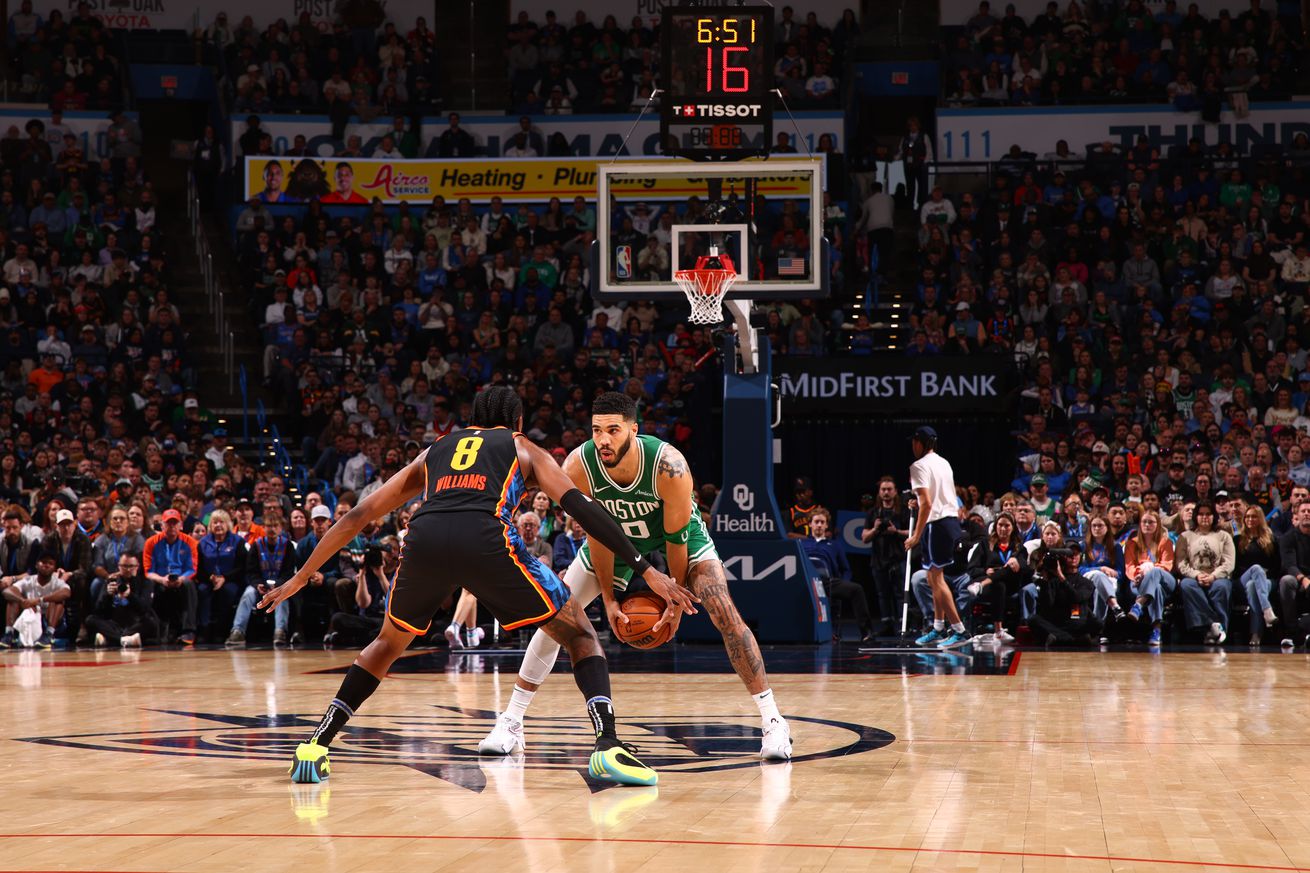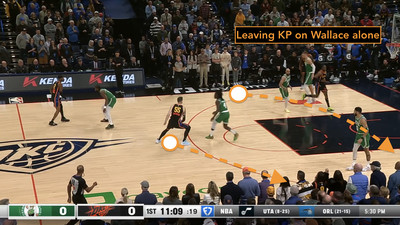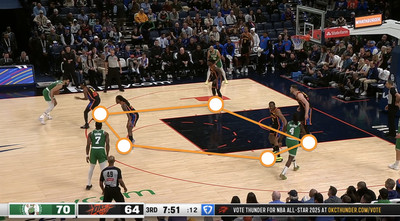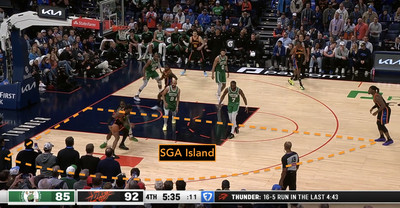
The Celtics and Thunder, two elite NBA contenders, clashed in a high-stakes battle of court geometry and spacing. Each team made tactical adjustments to carve out driving lanes and disrupt offensive flow, showcasing how small shifts can tilt the game’s balance at the highest level.
#1 – Court geometry
Court geometry last night was at the heart of the battle. Both teams set up their players in precise positions to ensure their stars had the most space to attack the rim. For example, to start the game, the Celtics set up Kristaps Porzingis against Cason Wallace so he could ignore him and remain close to the rim.

However, to counter that, all the OKC off-ball players moved to the opposite side of Cason Wallace and Porzingis. As a result, there was a lot of space on the left side, where only Wallace and Porzingis were. This allowed Shai Gilgeous-Alexander to drive to his left with all the space he needed. This also removed any rim protection from Porzingis, who could only try to disrupt the drive, but there was simply too much space.
On the other side, the Celtics also set up their players to give Jayson Tatum as much space as possible. The Celtics theoretically had better spacing than the Thunder, thanks to their centers who can shoot from three. Here, for example, Porzingis is dragging Isaiah Hartenstein away from the rim.
Additionally, as the Celtics are playing five-out, the stunts weren’t very effective on the drive, and the rim protection from Jalen Williams was a bit late. The geometry of the court and the location of every piece on the chessboard were key last night—and evolved in the second half. Indeed, if the Celtics scored only 27 points in the second half, it’s because OKC coach Mark Daigneault adjusted how his players would defend the Celtics’ spacing.
#2 – Shrink the floor
To beat the Celtics, you have to choose your poison and hope you chose wisely. That’s exactly what OKC did, but the Celtics also helped them a little bit. First, OKC was hoping that, thanks to hard closeouts, the Celtics would miss more three-pointers than usual—and they did. Three for 24 in the second half; this was a great imitation of the 2018 Houston Rockets in the Western Conference Finals.
To shrink the floor, the Thunder didn’t hesitate to constantly switch and sent two players to the ball when needed. After the Celtics created a lot of easy opportunities from post-ups in the first half, the Thunder decided to send two players and forced the ball to move. They preferred to run after the ball and contest the three rather than give the Celtics an easy path to the rim, and it worked.

Through the first half, the Celtics made 12 rim attempts out of 13; in the second, it was 2 out of 9. As Joe Mazzulla said, they didn’t do a good job with their spacing, and the Thunder’s adaptation derailed their usual offense.
#3 – Lazy passes
The Thunder is the best team at creating turnovers in the NBA. According to cleaningthelass.com, they force their opponents into a 20% turnover rate. This means that, on average, Thunder opponents lose the ball once every five possessions. After a clean first half, the Celtics were punished in the second.
The Thunder thrives on lazy passes—they wait patiently, in the dark, for their opponents to send a bad pass and steal the ball. Look at the video below where Derrick White tried an entry pass for Kristaps Porzingis:
Isaiah Hartenstein comes from behind, leaving Al Horford open and punishing the Celtics for an average pass sent into the middle of the paint. Overall, in the second half, the Celtics had 10 turnovers for 3 assists—that says a lot about the Celtics’ passing during the last 24 minutes.
#4 – Under pressure
Yet, lazy passing wasn’t the only cause of turnovers. The Celtics ball-handlers’ control wasn’t at its best last night, probably due to fatigue from the road trip and perhaps because Jaylen Brown was still in discomfort due to his injury.
Nonetheless, the Celtics couldn’t handle the pressure and physicality the Thunder applied yesterday. Even after an offensive rebound by the Celtics, the Thunder players acted like sharks smelling blood—then grabbed the ball from the Celtics’ tired hands.
Another great example of the Celtics’ fatigue and inability to deal with the Thunder’s pressure was the offensive fouls on screens. It’s rare to see that from the Celtics, but yesterday, you could feel that even the screens were hard to set, leading to more turnovers.
#5 – Empty side actions tactical battle
The battle around empty-side action was at the heart of the tactical adjustments. In the first half, the Celtics were able to punish the Thunder thanks to their spacing from these actions, leading to easy shots at the rim.
In the second half, the Thunder took these actions away. By switching everything, they didn’t concede any gaps—they rather conceded mismatches and sent two players.
In the action above, you can see that the Thunder doesn’t mind switching after a Payton Pritchard empty-side pick-and-roll or after a Jayson Tatum and Luke Kornet step-up screen. They don’t care because they absolutely don’t want to concede a gap that would open up the rim. Therefore, they keep switching and have the roster to be aggressive on the ball-handler and in the passing lanes, which leads to yet another turnover.
#6 – Double big lineups to shrink the floor even more
I’ve talked about the Celtics’ spacing issues, but the Thunder faced the same problem—the main difference was that they made the shots the Celtics didn’t expect them to. For example, Lu Dort, who the Celtics considered a non-shooting threat, made more three-pointers than the entire Celtics team in the second half.
With two big men, the Celtics could send two players on SGA after a pick-and-roll in the middle while keeping the other close to the rim. This forced turnovers and made SGA take difficult shots—or trust his teammates to shoot better than usual.
Lucky for the Thunder, that’s what happened. Nevertheless, there seem to be limitations to their spacing they need to address—but they are also creating ways to trick the floor geometry and still find space for SGA sometimes. The problem with these double-big lineups is that they don’t just take away the spacing for the opponents, they take it away for the Celtics too. Therefore, both teams were fighting to find space on a crowded floor.
#7 – Finding space on a crowded floor
While the Celtics struggled to find space for Jayson Tatum and Jaylen Brown, the Thunder created an island so SGA could attack Jrue Holiday one-on-one. After his comments on not liking to defend players like SGA, it’s no surprise to see that happening.
Over the summer, Jrue Holiday named SGA one of his least favorite players to guard in the NBA.
“The smaller, shiftier guys – hate it. Shai? Hate guarding him.”
Holiday explained that he prefers matchups where he can use his strength.
(via Sloane Knows podcast) pic.twitter.com/hCKWd0lgIx
— Noa Dalzell (@NoaDalzell) January 3, 2024
To create this island, the Thunder set up four players on the other side of the floor and forced the Celtics away. Therefore, the Celtics had the choice to either send another player and leave Jrue on an island—which they did.

SGA might be one of the best one-on-one players in the NBA, so I wonder if the Celtics will double him next game. Especially since it would be easier to double him while he is isolated on one side, with three Celtics covering the four other Thunder players.
#8 – Celtics’ inability to drag Hartenstein away
In the second half, the Celtics weren’t able to drag Hartenstein away. If you want to compare what they did to Sengun, you can read the previous ten takeaways. Why couldn’t they drag him away from the rim?
Well, usually the Celtics take away a center’s rim protection by forcing him to switch onto Jayson Tatum. However, Isaiah Hartenstein might be the toughest center to punish on mismatches. Therefore, the Celtics didn’t involve him as much in pick-and-roll actions.
Because of that, Hartenstein could be the low man in the paint and disrupt all the Celtics’ rim attempts. This is a great replica of what Memphis did a few weeks ago. The Celtics didn’t want to involve him in the pick-and-roll, and therefore, he could roam in the paint, leaving Jrue Holiday or Al Horford open. It’s worth noticing that more and more defenses are deciding to leave one of the Celtics open to protect the rim.
#9 – OKC transition defense
It was last night’s highlight, but there is more to it. Oklahoma City’s transition defense was stellar—not only on this SGA block over Jayson Tatum.
In transition, the Celtics scored 60 points per 100 possessions. Even worse, from their defensive rebounds, they rarely generated an attempt, and when they did, they only created 33 points per 100 possessions on these actions.
This shows two facets of the game I’ve pointed out in this article: the Celtics were out of energy, and the Thunder would rather die than give the Celtics an easy look.
#10 – One more challenge before going home
Before going back home, the Celtics have one last challenge. On Tuesday, they will face the Denver Nuggets, whom they haven’t beaten since November 2022. The Celtics have had trouble dealing with Nikola Jokić’s scoring and playmaking. Will they be able to turn it back on and bring the energy? The answer comes on Tuesday.